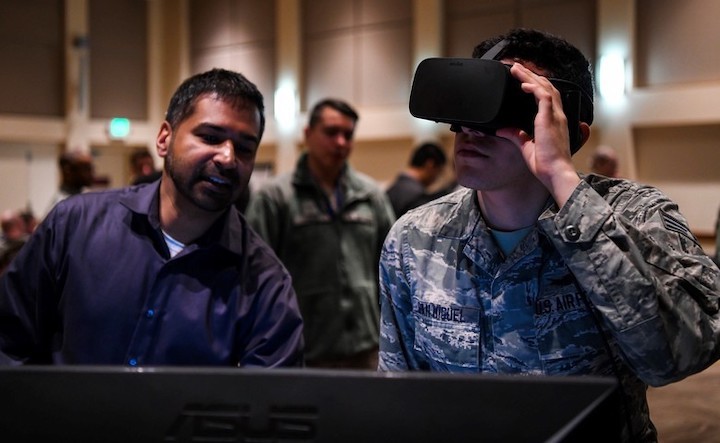3.04.2019

Senior Airman Taylor San Miguel, 11th Space Warning Squadron satellite systems operator, tries out a virtual reality headset Feb. 14, 2018, at Buckley Air Force Base, Colo. Space operators were encouraged to test the prototype space tools and give feedback on what should be improved in order to create a product operators could use effectively. (U.S. Air Force photo by Airman 1st Class Michael D. Mathews)
BUCKLEY AIR FORCE BASE. Colo. (AFNS) --
With evolution comes experimentation. Space is an ever-changing warfighting domain and the Air Force must continually evolve the way it budgets, acquires and develops its technology to maintain superiority in a place far above the skies.
In what may become the next evolution to the way the Air Force develops space technology, Buckley Air Force Base Airmen recently partnered with the 14th Air Force, Air Force Research Lab and Space and Missile Systems Center to innovate and enable warfighting. Through this collaboration, a new division was born within the 460th Space Wing called the Combat Development Division - the first of its kind in Air Force Space Command.
Maj. Gen. Stephen Whiting, 14th Air Force commander, plans to use CDDs to enable innovation from every level. CDDs tackle a new way of handling acquisitions in order to better enable the warfighter.
The traditional acquisition models require a more formal Department of Defense-defined processes that can create a lag in the fast-paced world of innovation. Members of the CDD believe a new approach to acquisition would not only improve the timeline between innovation and delivery of systems to the field, but also improve the effectiveness of those systems as well.
“We need our space operators to be able to develop capabilities that address their pain points, then deliver them to our ops floors faster than our competitors can,” said Capt. Jason Lowery, 14th Air Force strategic plans, programs and requirements lead. “That's why the CDD exists.”
Today, building tools for Airmen to be effective warfighters uses the traditional DoD acquisition process. This top-down approach starts by creating large, detailed operator requirements documents, breaking the problem and its solution down and reducing risk through research and development, then handing solutions to contractors to develop the tool and eventually, the tools are put into the hands of the operator. This process is easier to manage and less risky, but it usually takes years to complete and does not align with the fast-paced world of modern space technology.
Recognizing the need for acquisition reform, Dr. Will Roper, assistant secretary of the Air Force for acquisitions, technology, and logistics, signed new policy enabling Air Force acquisitions personnel to move faster.
“Our current regulation doesn’t appear to value speed,” Roper said during a recent press event with small businesses. “If this technology is available to everyone, then the only path to national security is through speed and agility … we have to get to market first.”
Inspired by Roper’s guidance, the CDD decided to test out the effectiveness of newly revised acquisition rules by creating a bottom-up process that focuses exclusively on current space operator needs.
“Many Airmen wait years to get better tools for their jobs, which isn't very useful for tactical operations, especially in today’s faster, more competitive space environment,” Lowery said. “Compared to traditional acquisition models, the new methods we’re testing are designed to give Airmen access to tools much, much sooner. If operators don’t like the tool, we can bail out early, or fix the tool, but either way we get to the right capability much faster and cheaper than before.”
The 460th Space Wing recently held a Demonstration Day to give space operators a chance to try out the CDD prototypes and give feedback. Operators were not only perplexed with how fast these prototypes were built, but also with how effective they were.
Lowery attributes the success of the first CDD effort to a highly innovative culture at Buckley AFB and outstanding support provided by AFRL’s Space Commercially Augmented Mission Platform, SMC’s Mission Innovation Office and the Enterprise Space Battle Management Command & Control program.
Through this partnership, Buckley AFB operators were able to work hand-in-hand with commercial companies, game designers and virtual reality experts to create new software that allows them to travel through space in virtual reality and see orbiting satellites and constellations in real time. The VR system allows operators to “fly” up to individual satellites and take them apart piece by piece to diagnose and analyze the health of the satellite’s mechanics. This new tool gives space operators an entirely new perspective, bringing them into space as if the satellite had its own cockpit and instrument panel.
Maj. Rob Slaughter, creator of the Air Force software development incubator named Space CAMP, recalled his experience working with Buckley AFB operators.
“They needed a better way to visualize their environment, so we set them up with business partners in the gaming industry,” Slaughter explained. “The solution they designed looks like a video game, but once we plug in the right data feeds, operators have a real-world, accurate, tactical common operating picture, and this is only the first 90 days.”
“We have to be agile,” said Lt. Col. Matthew Collins, 460th Operation Support Squadron director of operations. “There is a time and place for traditional acquisition models, but the pace at which technology is developing today forces us to be equally or more agile. In order to maintain our position in space, we have to be innovative, think outside the box, and we absolutely have to go faster.”
The CDD and its commercial partners are continuing to work on prototypes with feedback from operators to push out products that are usable in the field.
Quelle: USAF
